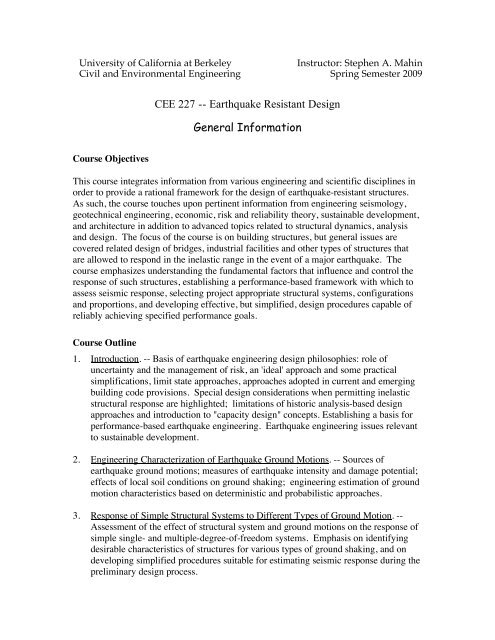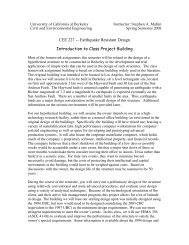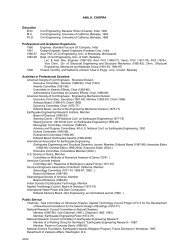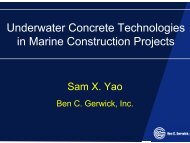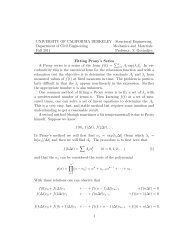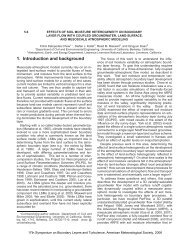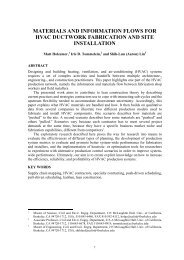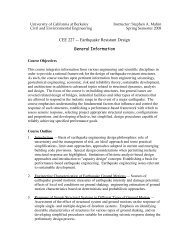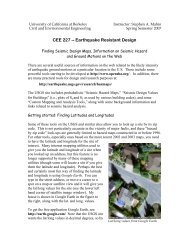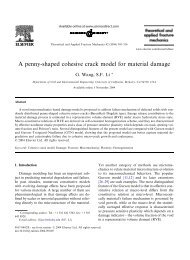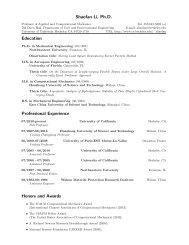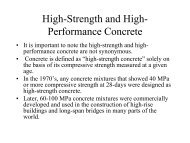CEE 227 -- Earthquake Resistant Design General Information
CEE 227 -- Earthquake Resistant Design General Information
CEE 227 -- Earthquake Resistant Design General Information
You also want an ePaper? Increase the reach of your titles
YUMPU automatically turns print PDFs into web optimized ePapers that Google loves.
University of California at Berkeley<br />
Civil and Environmental Engineering<br />
Instructor: Stephen A. Mahin<br />
Spring Semester 2009<br />
<strong>CEE</strong> <strong>227</strong> -- <strong>Earthquake</strong> <strong>Resistant</strong> <strong>Design</strong><br />
<strong>General</strong> <strong>Information</strong><br />
Course Objectives<br />
This course integrates information from various engineering and scientific disciplines in<br />
order to provide a rational framework for the design of earthquake-resistant structures.<br />
As such, the course touches upon pertinent information from engineering seismology,<br />
geotechnical engineering, economic, risk and reliability theory, sustainable development,<br />
and architecture in addition to advanced topics related to structural dynamics, analysis<br />
and design. The focus of the course is on building structures, but general issues are<br />
covered related design of bridges, industrial facilities and other types of structures that<br />
are allowed to respond in the inelastic range in the event of a major earthquake. The<br />
course emphasizes understanding the fundamental factors that influence and control the<br />
response of such structures, establishing a performance-based framework with which to<br />
assess seismic response, selecting project appropriate structural systems, configurations<br />
and proportions, and developing effective, but simplified, design procedures capable of<br />
reliably achieving specified performance goals.<br />
Course Outline<br />
1. Introduction. -- Basis of earthquake engineering design philosophies: role of<br />
uncertainty and the management of risk, an 'ideal' approach and some practical<br />
simplifications, limit state approaches, approaches adopted in current and emerging<br />
building code provisions. Special design considerations when permitting inelastic<br />
structural response are highlighted; limitations of historic analysis-based design<br />
approaches and introduction to "capacity design" concepts. Establishing a basis for<br />
performance-based earthquake engineering. <strong>Earthquake</strong> engineering issues relevant<br />
to sustainable development.<br />
2. Engineering Characterization of <strong>Earthquake</strong> Ground Motions. -- Sources of<br />
earthquake ground motions; measures of earthquake intensity and damage potential;<br />
effects of local soil conditions on ground shaking; engineering estimation of ground<br />
motion characteristics based on deterministic and probabilistic approaches.<br />
3. Response of Simple Structural Systems to Different Types of Ground Motion. --<br />
Assessment of the effect of structural system and ground motions on the response of<br />
simple single- and multiple-degree-of-freedom systems. Emphasis on identifying<br />
desirable characteristics of structures for various types of ground shaking, and on<br />
developing simplified procedures suitable for estimating seismic response during the<br />
preliminary design process.
CE <strong>227</strong> – <strong>Earthquake</strong> Engineering <strong>Design</strong> (Introduction) 2<br />
4. Development of <strong>Design</strong> <strong>Earthquake</strong>s for Linear Structural Response. -- Identification<br />
of critical parameters -- influence of local soil conditions and structural damping;<br />
development of design spectrum.<br />
5. Development of <strong>Design</strong> <strong>Earthquake</strong>s for Nonlinear Structural Response. -<br />
Identification of critical parameters -- influence of local soil conditions, viscous<br />
damping, duration of shaking, nonlinear mechanical characteristics of the structure,<br />
and geometric nonlinearities; development of design spectra from ground motion<br />
and structural characteristics; displacement estimates; alternative spectra formats;<br />
extension of design spectra to multi-degree of freedom systems.<br />
6. Analytical Procedures for Preliminary/Conceptual <strong>Design</strong> and Proportioning of<br />
Structural Systems. – Review of simple plastic theory; estimation of the maximum<br />
strength and deformation capacities of structural systems; simplifications for design<br />
of multistory structures; application of capacity design methods. Emphasis on<br />
ductile moment-resisting frames and braced frames. Methods discussed to control<br />
displacements and other response parameters of structural interest.<br />
7. Code Related Issues. -- Basis and limitations of current code provisions for<br />
structural analysis and design. Future trends. Nonlinear static pushover procedures<br />
for evaluation of new and existing structures, development of target displacements.<br />
8. Basic Performance-based Evaluation and <strong>Design</strong> Issues. -- Lessons from past<br />
earthquakes; quantification of performance objectives and levels for seismic<br />
resistant design; Selection of analysis procedures; numerical modeling of structural<br />
systems. Estimation of fragility functions and quantifying the confidence of a<br />
structure’s ability to achieve a targeted performance objective. Current and<br />
emerging guidelines for the evaluation of existing and new structures.<br />
9. Applications. -- Steel (and to a lessor extent reinforced concrete) details to insure<br />
member and connection ductility; basic design considerations for moment-resisting<br />
frames and concentrically braced frames. Application of concepts to structures<br />
employing seismic isolation or utilizing supplemental energy dissipation devises.<br />
Self-centering systems.<br />
Prerequisites<br />
Students are expected to have a background in structural analysis and structural<br />
dynamics. A basic understanding of inelastic structural analysis is required. Courses such<br />
as <strong>CEE</strong> 220 and <strong>CEE</strong> 225, or their substantial equivalent, satisfy this requirement.<br />
Students uncertain about the adequacy of their preparation should contact the instructor.
CE <strong>227</strong> – <strong>Earthquake</strong> Engineering <strong>Design</strong> (Introduction) 3<br />
Course Organization<br />
Lectures:<br />
Discussion Session:<br />
Tu-Th 11 AM -12:30 PM; 534 Davis Hall<br />
time and location TBD<br />
The weekly discussion session will be devoted to discussion of the conceptual and<br />
analytical approaches presented in the class and for help in solving homework<br />
assignments. Make up lectures will be, to the extend possible, held in the time slot<br />
assigned to the discussion section. The time of the discussion session may be changed to<br />
make it more convenient for students to attend.<br />
Exams: There will be two 80 minute long midterms. There will be no final exam, but a<br />
final term project will be required.<br />
Term Project: The term project may be done individually or in groups of two. The intent<br />
of the term project is for the student to undertake a significant, but short project related to<br />
the design or analysis of structures, development of software to assist in the seismic<br />
resistant design of structures, or other application of the material learned in the course.<br />
The choice of topic is left to the student, but instructor approval is required. A separate<br />
handout will describe the scope and requirements for the term project. Larger groups are<br />
possible, but require special prior approval by the instructor.<br />
Grades: Grades will be based on performance on homework assignments, several<br />
midterm quizzes, and a final term project, according to the following approximate<br />
weights: 25%, 40% and 35%.<br />
Contact <strong>Information</strong><br />
Instructor: Prof. Stephen Mahin Teaching Assistant: Abby Enscoe<br />
Office: 777 Davis Hall 504 Davis Hall<br />
Phone: 510-693-6972 (Mobile)<br />
Email: mahin@berkeley.edu enscoe@berkeley.edu<br />
Office Hours: TuTh 12:45-2:00 PM<br />
TBD<br />
Course Web Site<br />
A website has been developed for the class. It provides a means of accessing copies of<br />
class notes prior to the lecture (please download these if you would like to have them<br />
during the lectures), copies of handouts, homework assignments and solutions,<br />
references, practice exams and study questions, various photos and movies, and links to<br />
various other web sites related to earthquake engineering. There is also a class blog for<br />
timely communication of late breaking information about the class. The website can be<br />
accessed at:<br />
URL: http://web.mac.com/smahin/CE<strong>227</strong>-09/CE<strong>227</strong>.html<br />
User Name: ce<strong>227</strong><br />
Password: Berkeley
CE <strong>227</strong> – <strong>Earthquake</strong> Engineering <strong>Design</strong> (Introduction) 4<br />
Required Course Materials<br />
The course does not have a textbook per se. The field of earthquake engineering design<br />
is changing quite rapidly, and few books currently provide adequate coverage of all of the<br />
topics covered in the course. Extensive course notes and references will be provided online.<br />
You will need to go to the library to find some necessary references.<br />
Students are expected to regularly read papers and sections of reports to prepare for<br />
exams, complete homework assignments and execute the class project. Specific reading<br />
assignments will be made from the following sources:<br />
1. Introduction to Structural Dynamics and <strong>Earthquake</strong> Engineering by Anil<br />
Chopra, Prentice Hall, 2001.<br />
2. ASCE/SEI Standard 41-06 Seismic Rehabilitation of Existing Buildings, ASCE,<br />
2006 (available early 2007), or NEHRP Guidelines for the Seismic<br />
Rehabilitation of Buildings (FEMA 356), FEMA/ASCE, Washington DC, 1997.<br />
ASCE 41 is costly, so we will focus mainly on FEMA 356. Download FEMA<br />
356 from: http://www.fema.gov/plan/prevent/earthquake/professionals.shtm<br />
3. State of the Art Report on Performance Prediction and Evaluation of Steel<br />
Moment-Frame Structures (FEMA 355F), FEMA, Washington, DC. Download<br />
from class web site.<br />
4. Improvement of Nonlinear Static Seismic Analysis Procedures (FEMA 440),<br />
FEMA, Washington DC. Download from<br />
http://www.fema.gov/plan/prevent/earthquake/professionals.shtm<br />
5. The 2003 NEHRP Recommended Provisions For New Buildings And Other<br />
Structures (FEMA 450) FEMA, Washington DC, 2000. Download from<br />
http://www.bssconline.org/NEHRP2003/provisions/<br />
6. Seismic Evaluation and Upgrade Criteria for Existing Welded Steel Moment-<br />
Frame Buildings (FEMA 351), FEMA, Washington DC, July 2000.<br />
http://www.fema.gov/plan/prevent/earthquake/professionals.shtm<br />
Hard copies of these and other FEMA documents can be obtained for free by calling<br />
1-800-480-2520.<br />
A basic reading list is provided. Additional reading assignments will be announced in<br />
class, and posted on the website or listed in the homework assignments. A more<br />
extensive set of reading material is provided on the class web site.<br />
Several SAC/FEMA state-of-the-art reports are of particular interest to the class. These<br />
include will be available for down load from the class website. Of special interest to this<br />
class are:<br />
1. FEMA 355C, State of the Art Report on Systems Performance of Steel Moment<br />
Frames Subject to <strong>Earthquake</strong> Ground Shaking
CE <strong>227</strong> – <strong>Earthquake</strong> Engineering <strong>Design</strong> (Introduction) 5<br />
2. FEMA 355E, State of the Art Report on Past Performance of Steel Moment-<br />
Frame Buildings in <strong>Earthquake</strong>s.<br />
Hardcopies of these and similar SAC reports on steel construction in seismic areas can be<br />
obtained for a fee from: http://www.atcouncil.org.<br />
Computer Software<br />
Several computer programs will be utilized in the course to illustrate concepts and to<br />
complete homework assignments. These include:<br />
1. Homework assignments will require matrix computations and numerical<br />
integration. As such, students are expected to be familiar with and have access to<br />
Matlab, MathCAD, Excel or similar software.<br />
2. The program BiSpec, used for computing the response of single degree of<br />
freedom subjected to one or two horizontal components of excitation. This<br />
program will be extensively used and should be downloaded from:<br />
http://www.ce.berkeley.edu/~hachem/bispec/index.html . Program manuals (online<br />
and downloadable PDF files) can be obtained from the same site.<br />
3. Students will complete a number of assignments related to the nonlinear static<br />
and dynamic analysis of simple 2D framed structures. The computer program to<br />
be used is left to the student. Various computer programs are available:<br />
a. OpenSEES Navigator - Available for download from:<br />
http://peer.berkeley.edu/OpenSeesNavigator/<br />
This program is a Matlab-based application and requires Matlab 6.1 or<br />
higher, in addition to a copy of OpenSEES computational framework (see<br />
http://opensees.berkeley.edu/). A tutorial on installing and using these<br />
programs will be given in the discussion sections).<br />
b. Fedeas Lab – Available at:<br />
http://www.ce.berkeley.edu/~filippou/FEDEASLab/FEDEASLab.htm<br />
This program is very powerful and simpler to use than OpenSees. It is<br />
also used as the primary analytical platform in CE 221. A fully<br />
operational version, capable of nonlinear static and dynamic analysis of<br />
structures will be available soon after the beginning of the semester.<br />
c. CSI Perform, SAP, ETABS, etc – various versions of Perform, SAP and<br />
ETABS (and other commercial programs) may be on the department<br />
computer system and otherwise available to students.<br />
Reference Material<br />
A wide variety of reference material is available. For example, several good (but<br />
expensive) textbooks exist. These may provide useful information on a number of topics<br />
not covered by course notes. These books include:<br />
1. <strong>Earthquake</strong> Engineering: From Engineering Seismology to Performance-<br />
Based Engineering, Yousef Borzorgnia and Vitelmo Bertero, Eds., CRC Press,<br />
2004 (available on line from http://melvyl.cdlib.org)
CE <strong>227</strong> – <strong>Earthquake</strong> Engineering <strong>Design</strong> (Introduction) 6<br />
2. <strong>Earthquake</strong> Engineering Handbook, W-F. Chen, C. Scawthorn, CRC Press,<br />
2002.<br />
3. Introduction to Structural Motion Control, Connor, J. J. Prentice Hall, August<br />
2002.<br />
4. Seismic <strong>Design</strong> For Architects: Outwitting the Quake, Architectural<br />
Press/Elsevier, 2008.<br />
5. The Seismic <strong>Design</strong> Handbook, F. Naeim, Ed., Kluwer Academic Publishers,<br />
2001<br />
6. Introduction to Structural Dynamics and <strong>Earthquake</strong> Engineering, Anil<br />
Chopra, Prentice Hall, 2001.<br />
7. Geotechnical <strong>Earthquake</strong> Engineering, Steven Kramer, Prentice Hall, 1996.<br />
8. <strong>Earthquake</strong> Engineering, Hu, Y-X, Liu, S-C and Dong, W, E&FN Spon,<br />
London, 1996<br />
9. <strong>Earthquake</strong> Risk Reduction, Dorwick, D., Wiley, New York, NY, 2003.<br />
10. <strong>Design</strong> of <strong>Earthquake</strong> <strong>Resistant</strong> Buildings, Wakabayashi, M., McGraw-Hill,<br />
New York, NY, 1986.<br />
11. Fundamentals of <strong>Earthquake</strong> Engineering, Newmark, N. and Rosenblueth, E.,<br />
Prentice Hall, New York, NY, 1971.<br />
12. Fundamentals of <strong>Earthquake</strong> Engineering, Elnashai, A. and Sarno, L., Wiley,<br />
2008.<br />
13. <strong>Design</strong> of Ductile Steel Structures, Bruneau, M., Uang, C-M, and Whittaker, A.,<br />
McGraw-Hill, 1997.<br />
14. Steel Structures: Controlling Behavior Through <strong>Design</strong>, Robert Englekirk,<br />
Wiley, 1995.<br />
15. Seismic <strong>Design</strong> of Reinforced Concrete and Masonry Buildings, Paulay, T. and<br />
Priestley, N., John Wiley & Sons, 1992.<br />
16. Seismic <strong>Design</strong> and Retrofit of Bridges, M. J. N. Priestley, F. Seible, G. M.<br />
Calvi, Wiley-Interscience, 1996.<br />
Some other useful, code-related documents include:<br />
1. Recommended Seismic <strong>Design</strong> Criteria for New Steel Moment-Frame<br />
Buildings, FEMA 350, Federal Emergency Management Agency, Washington<br />
DC, July 2000. http://www.fema.gov/plan/prevent/earthquake/professionals.shtm<br />
2. Recommended Post-<strong>Earthquake</strong> Evaluation and Repair Criteria for Welded Steel<br />
Moment-Frame Buildings (FEMA 352), FEMA, Washington DC, July 2000.<br />
http://www.fema.gov/plan/prevent/earthquake/professionals.shtm<br />
3. Specifications and Quality Assurance Guidelines for Steel Moment-Frame<br />
Construction for Seismic Applications (FEMA 353), FEMA, Washington DC,<br />
http://www.fema.gov/plan/prevent/earthquake/professionals.shtm<br />
4. SEAOC, Recommended Lateral Force Requirements and Commentary (the<br />
“Blue Book”), Sacramento, CA, 1999 (see http://www.seaoc.org/)
CE <strong>227</strong> – <strong>Earthquake</strong> Engineering <strong>Design</strong> (Introduction) 7<br />
5. California Building Code, Title 24, California Administrative Code, 2007 edition<br />
(see: http://www.bsc.ca.gov/title_24/default.htm)<br />
6. HAZUS, a natural hazard loss estimation methodology, FEMA in partnership<br />
with the National Institute of Building Sciences, Washington DC.<br />
http://www.fema.gov/plan/prevent/hazus/index.shtm<br />
Note that hardcopies of FEMA documents may be generally obtained for free by calling<br />
1-800-480-2520.<br />
Web-Based Resources<br />
A number of specific links are provided on the class website. Some particularly<br />
important sources of information include:<br />
1. The National <strong>Information</strong> Service for <strong>Earthquake</strong> Engineering (NISEE) has its<br />
library at the Richmond Field Station. It has the worlds largest library related to<br />
earthquake engineering. The WWW site for NISEE has a variety of user features,<br />
including an on-line search feature, library of earthquake damage photos,<br />
downloadable computer programs, and so on. The homepage for NISEE is<br />
http://nisee.berkeley.edu/<br />
In addition to a <strong>Earthquake</strong> Engineering On-Line Archive of Berkeley related<br />
information and conference proceedings, the <strong>Earthquake</strong> Engineering Abstracts<br />
allows you to get access and download papers from most journals in the world<br />
related to earthquake engineering.<br />
2. The Pacific <strong>Earthquake</strong> Engineering Research (PEER) Center. The center<br />
headquarters are located on the 3 rd floor of Davis Hall. A variety of reports, and<br />
other information can be obtained from: http://peer.berkeley.edu


